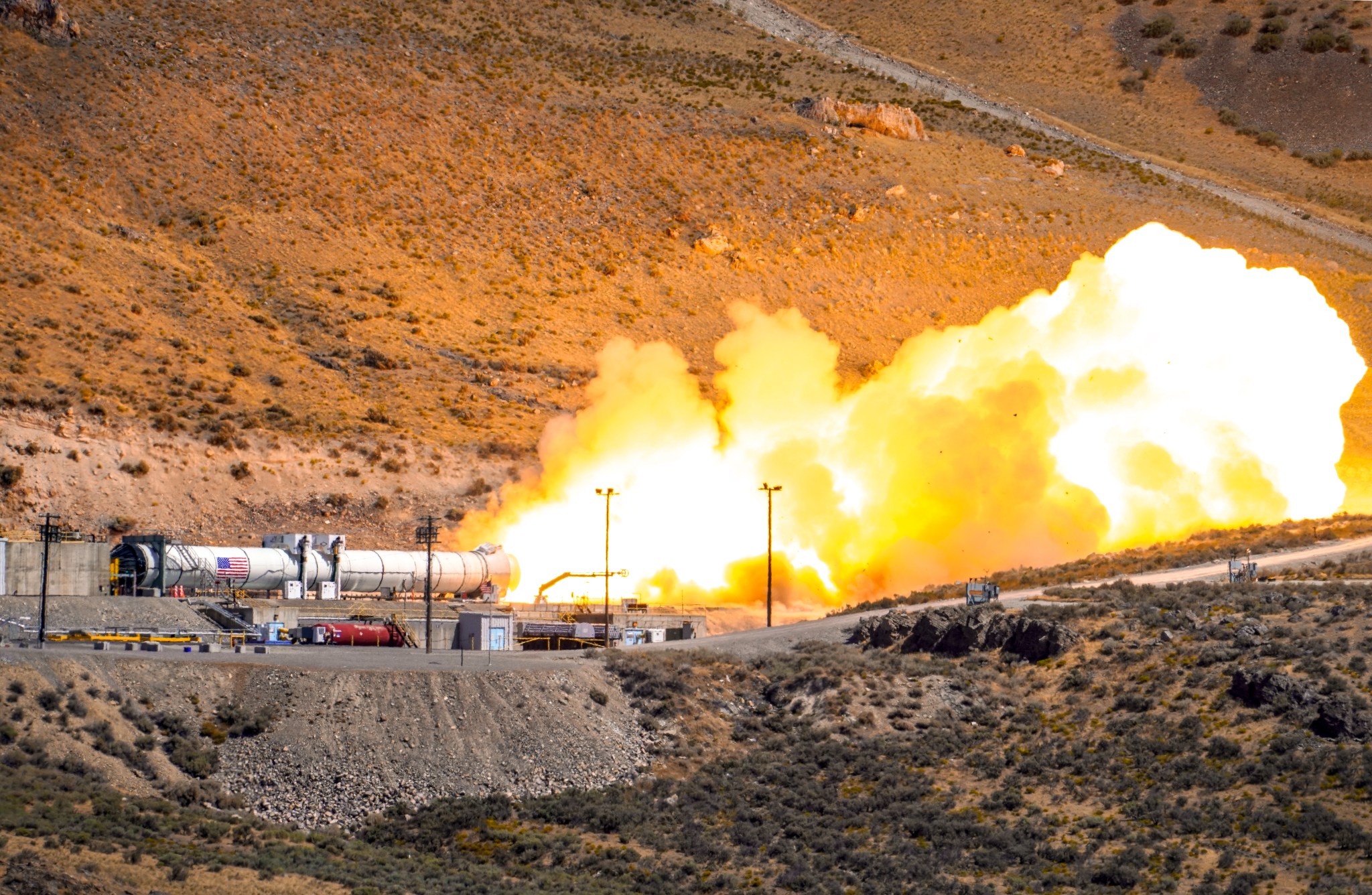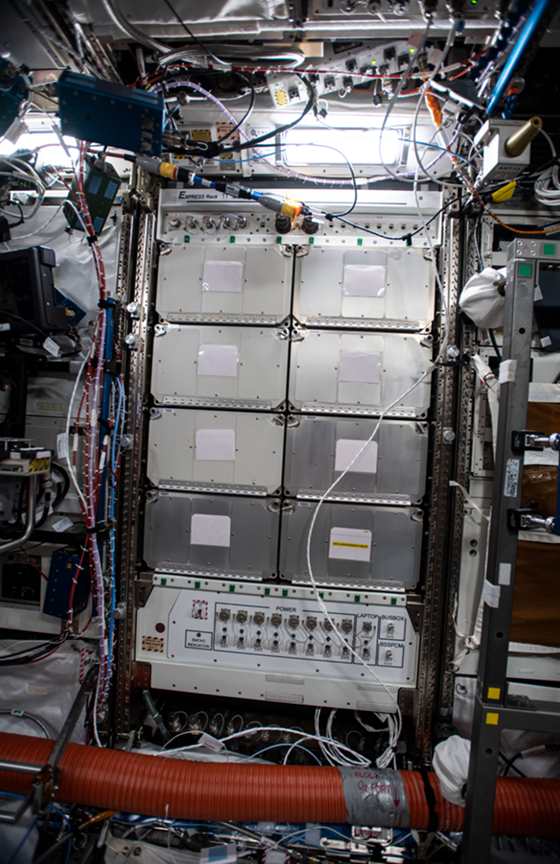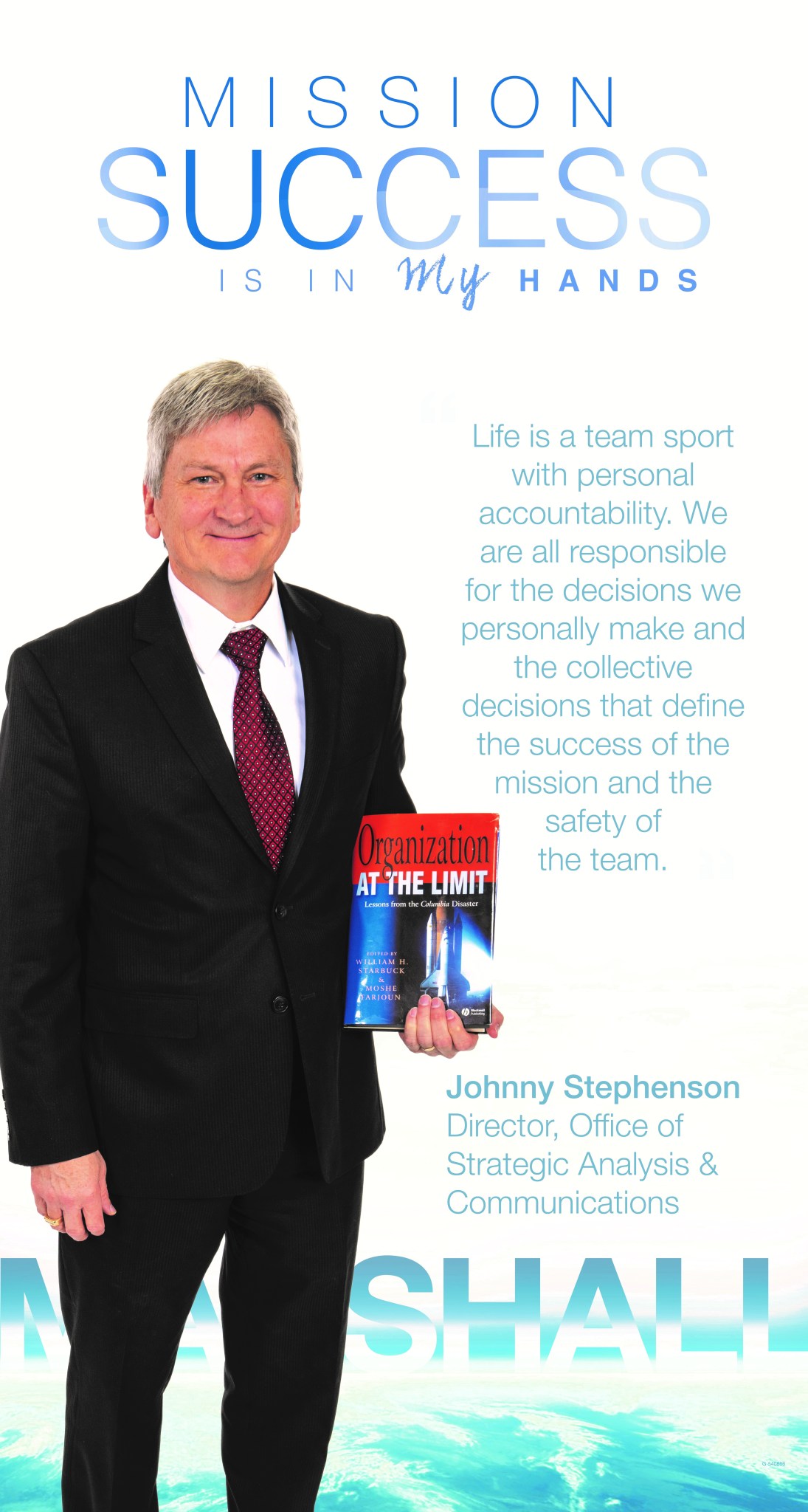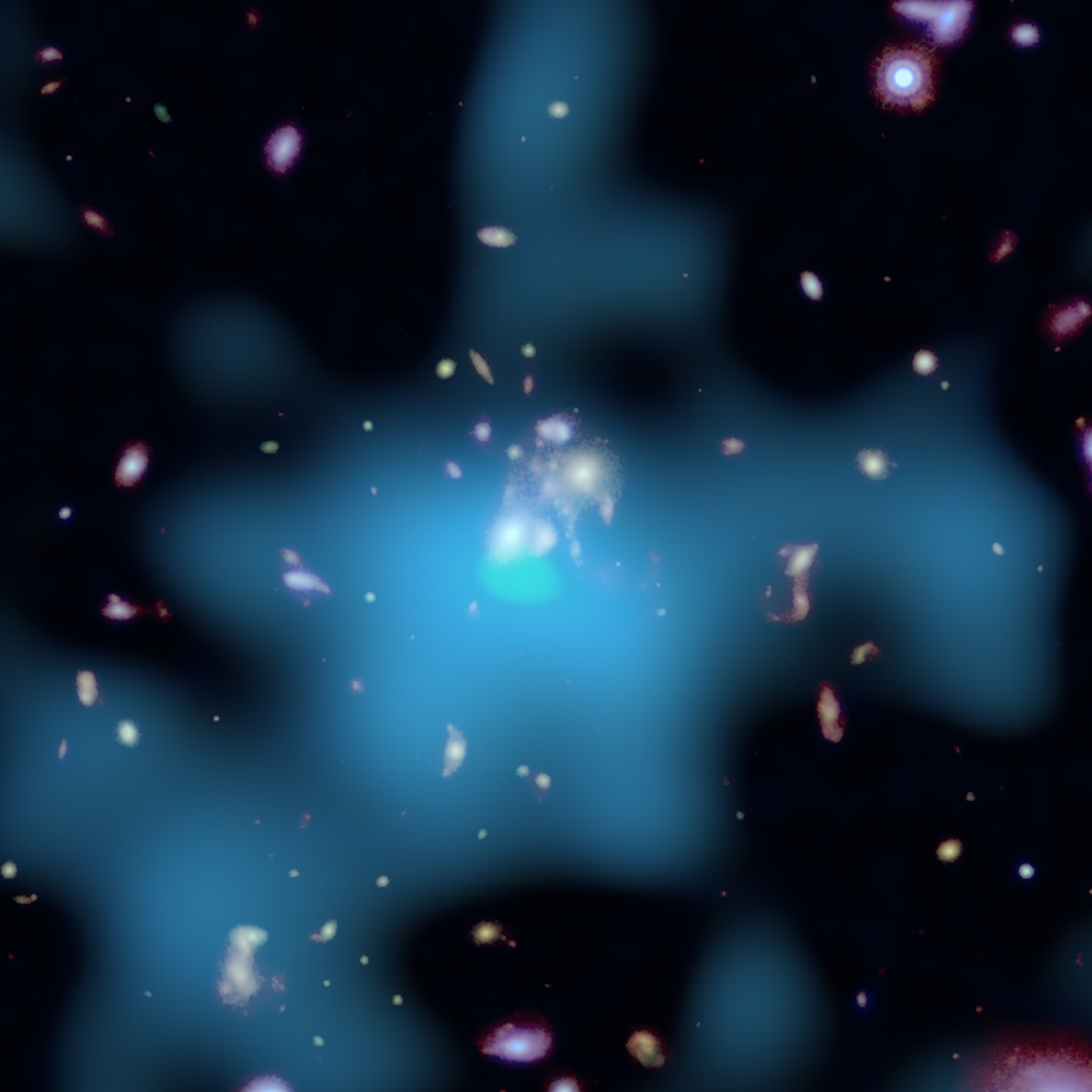In This Week’s Star
- Marshall Leadership Holds Live Virtual Town Hall
- NASA Conducts SLS Booster Test for Future Artemis Missions
- Busy Day of Science Rack Swaps Aboard Space Station
- Mission Success is in My Hands: Johnny Stephenson
- Marshall Launches New SharePoint Online-Based Intranet
- Chandra, Other Imaging Telescopes Document Busy Star Formation Near Inactive Black Hole
- This Week in NASA History: Formal Dedication of Marshall – Sept. 8, 1960
Marshall Leadership Holds Live Virtual Town Hall
By Daniel Boyette
Leadership at NASA’s Marshall Space Flight Center held their first live virtual town hall Sept. 3. Marshall Director Jody Singer, Deputy Director Paul McConnaughey, and Associate Director Steve Miley discussed a number of topics and answered questions submitted by team members.
The coronavirus pandemic and its effect on working locations remained a focal point, as did the significant accomplishments achieved by Marshall team members over the last several months, both virtually and on-site. Singer noted impressive accomplishments by the Human Landing System Program, Payload Operations Integration Center, Commercial Crew Program, Earth Science Disasters Support Team, and IXPE team.
McConnaughey recognized work done by the Engineering Directorate, Office of the Chief Information Officer, Office of Center Operations, and by mission support personnel in procurement, logistics, and communications.
“I’m so proud of the team,” Singer said, “for how you’re moving forward, regardless of where and how you’re working.”
All NASA centers and facilities are at Stage 3 of the agency’s Framework for Return to On-Site Work. Singer and other center directors have closely monitored COVID-19 cases at their respective center, and they agreed that it was best to wait until after Labor Day before reassessing any stage transitions.
“At Marshall, we’re turning on (on-site) work very diligently and very methodically, with risk-based assessments,” Singer said. “That will still be a critical part of what we do in Stage 2. We have to make sure that we don’t put any of our workforce into critical-risk areas. We are looking at all the information around us, locally and nationally, and stay in sync with Redstone Arsenal as far as protocols.”
The majority of Marshall’s workforce has teleworked since March 16. Singer and McConnaughey praised team members’ mission execution during the time of telework.
McConnaughey acknowledged the challenges of such a setup – including helping children with virtual school and caring for elderly parents – and that many are working more hours from home than they did at the office. He asked that team members extend extra patience and understanding to co-workers, and encouraged workers to communicate challenges to supervisors.
McConnaughey reminded civil servants that multiple options are available for leave: 20 hours of excused leave per pay period for dependent care, a new paid parental leave that is available Oct. 1, and the Families First Coronavirus Response Act for paid sick leave. He also urged civil servants to take advantage of their annual leave.
“Please take time to be kind to yourself,” he said. “Take time to step away from your job, if you feel like you can’t do it. Do things that you need to do to manage your physical, mental, and spiritual sanity.”
Because Marshall team members have shown the ability to accomplish numerous tasks via telework, such an arrangement is expected to be an option to many in a post-pandemic environment, Miley said.
“With a blended work environment, there will be more use of telework and a lot more use of flexible office space for our center,” he said “This is not unique to Marshall. There is an agencywide team looking at a blended work environment and expanded telework.”
Beginning Sept. 25, Marshall’s Flex Friday will switch to the second Friday of the pay period. This change comes in order to align Flex Friday with the agency’s new Quiet Friday initiative, which aims to set aside a day with no meetings. This will offer team members a set day to focus on work priorities and deadlines without meeting interruptions, allowing for work-life balance and the ability to take time off without feeling pressure to be available for meetings. Miley said that Marshall will not change its Flex Friday setup, which allows civil servants the flexibility to work 80 hours over nine days, and take every other Friday off.
“Don’t worry if you have something planned far in advance on an original Flex Friday date,” Miley said. “We are going to ask our supervisors to help you with flexibility around shifting your Flex Friday, if you need to, in order to make it sync up with the agency Quiet Friday.”
Contractors should check with their program manager for guidance on how to observe Quiet Friday.
“It takes all of us to keep the center running and to deliver on our missions,” said Singer, as she closed the virtual meeting. “We just can’t let our guard down. We’ve been very successful in many ways of avoiding transmission on-site because of the great job you are doing and because of the protocols. Please, keep up the good work and continue to let us know how we can help you.”
Boyette, an ASRC Federal/Analytical Services employee and Marshall Star editor, supports the Office of Strategic Analysis & Communications.
NASA Conducts SLS Booster Test for Future Artemis Missions
As NASA begins assembling the boosters for the agency’s Space Launch System rocket that will power the first Artemis mission to the Moon, teams in Utah are evaluating materials and processes to improve rocket boosters for missions after Artemis III.
NASA completed a full-scale booster test for the SLS rocket in Promontory, Utah, on Sept. 2. NASA and Northrop Grumman, the SLS booster lead contractor, will use data from the test to evaluate the motor’s performance using potential new materials and processes that can be incorporated into future boosters. NASA has a contract with Northrop Grumman to build boosters for future rocket flights.
“Landing the first woman and the next man on the Moon is just the beginning of NASA’s Artemis program,” NASA Administrator Jim Bridenstine said. “The SLS flight support booster firing is a crucial part of sustaining missions to the Moon. NASA’s goal is to take what we learn living and working on the Moon and use it to send humans on the first missions to Mars.”
For a little over two minutes – the same amount of time that the boosters power the SLS rocket during liftoff and flight for each Artemis mission – the five-segment flight support booster fired in the Utah desert, producing more than 3.5 million pounds of thrust.
NASA and Northrop Grumman have previously completed three development motor tests and two qualification motor tests. The Flight Support Booster-1 builds on prior tests with the introduction of propellant ingredients from new suppliers for boosters on SLS rockets to support flights after Artemis III.
The flight support booster test builds on prior tests and will allow NASA and Northrop Grumman, the SLS booster lead contractor, to evaluate the motor’s performance using potential new materials and processes for future booster performance.
NASA is working to land the first woman and next man on the Moon by 2024. The SLS rocket, Orion spacecraft, Gateway, and Human Landing System are part of NASA’s backbone for deep space exploration. The Artemis program is the next step in human space exploration. It’s part of America’s broader Moon to Mars exploration approach, in which astronauts will explore the Moon. Experience gained there will enable humanity’s next giant leap: sending humans to Mars. SLS is the only rocket that can send Orion, astronauts and supplies to the Moon in a single mission. Credits: NASA/Northrop Grumman/Scott Mohrman
“NASA is simultaneously making progress on assembling and manufacturing the solid rocket boosters for the first three Artemis missions and looking ahead toward missions beyond the initial Moon landing,” said John Honeycutt, SLS Program manager at NASA’s Marshall Space Flight. Center. “Today marks the first flight support booster test to confirm the rocket motor’s performance using potential new materials for Artemis IV and beyond.”
The SLS boosters are the largest, most powerful boosters ever built for flight. The flight support booster used in the test is the same size and has the same power as the flight version of a five-segment solid rocket booster used for NASA’s Artemis missions. The Artemis I boosters are currently being prepared for launch at NASA’s Kennedy Space Center.
“This flight support booster test is the first motor firing NASA and Northrop Grumman have completed since qualifying the booster design for the Space Launch System rocket,” said Bruce Tiller, SLS Boosters Office manager at Marshall. “Full-scale booster tests are rare, so NASA tries to test multiple objectives at one time so we are highly confident that any changes we make to the boosters will still enable them to perform as expected on launch day.”
Busy Day of Science Rack Swaps Aboard Space Station
Sept. 1 was a busy moving day aboard the International Space Station as the Expedition 63 crew reorganized science racks.
Since its inception, the orbiting lab’s main focus has been research that is only possible in microgravity. Scientists take advantage of these unique insights to improve health and industry for humans on Earth and in space. A variety of specialized racks throughout the station’s laboratory modules host numerous science experiments revealing phenomena only seen in weightlessness.
Commander Chris Cassidy of NASA and Flight Engineer Ivan Vagner of Russian space agency Roscosmos partnered to move three dedicated science racks, also known as Expedite the Processing of Experiments to the Space Station or ExPRESS, and installed them inside the U.S. Destiny, Japan’s Kibo and Europe’s Columbus lab modules. The moves will support future experiments being delivered on an upcoming Cygnus resupply mission from Northrop Grumman.
There are 11 refrigerator-sized ExPRESS racks installed on the station supporting a multitude of experiments. The final rack was delivered in May aboard the Japanese HTV-9 resupply ship. The ExPRESS racks, jointly built and tested at NASA’s Marshall Space Flight Center by NASA and The Boeing Co., have been integral to station science for almost 20 years – yielding a combined 85 years of science rack operations.
“The first ExPRESS rack was delivered to the space station in 2001,” said Brian Odom, acting NASA chief historian. “As we embark on 20 years of human presence on the station, hardware such as the EXPRESS rack has enabled extensive science research.”
Each ExPRESS rack comes equipped with up to eight configurable lockers and two drawers to house payloads, Experiments can be conducted, removed independently, and returned to Earth, according to varying time requirements.
These permanent fixtures on the station support a variety of research and provide power, protective storage, cooling and heating, command and data communications, and easy transport for up to 10 small payloads each.
“At any given time, up to 80 experiments can be in process, controlled by station crew members or from the ground,” said Shaun Glasgow, project manager for the ExPRESS racks at Marshall. “The ExPRESS racks operate at near capacity around the clock.”
Marshall oversees space station hardware development and implementation for NASA, and agency personnel at Marshall’s Payload Operations Integration Center monitor experiments continuously. As NASA’s primary space station science command post, the Payload Operations Integration Center coordinates scientific and commercial experiments on the station, synchronizes payload activities of international partners, and directs communications between researchers around the world and their onboard experiments. To help the crew in orbit conduct scientific study, the operations center is staffed 24 hours a day, seven days a week, 365 days a year.
For almost 20 years, since the Expedition 1 crew arrived Nov. 2, 2000, humans have lived and worked continuously aboard the space station. This orbiting laboratory has advanced capabilities in long-duration human space operations and in conducting scientific research and technology development in space. The space station remains the sole, space-based proving ground, greatly enabling NASA to go forward to the Moon and Mars. Under this unique international partnership, 240 people from 19 countries have visited the station, which has hosted more than 3,000 research investigations from researchers in 108 countries and areas.
For information on the space station, visit here. For more information on history of EXPRESS racks, visit here and here.
Mission Success is in My Hands: Johnny Stephenson
Editor’s note: This is the sixth in a series of articles spotlighting how eight team members at NASA’s Marshall Space Flight Center make meaningful connections between their jobs and the safety and success of NASA and Marshall missions. The Mission Success Is in Our Hands initiative is a centerwide campaign led by Marshall’s Safety and Mission Assurance Directorate and partner Jacobs Engineering of Huntsville that promotes and strengthens the center’s focus on mission, hardware, and crew safety.
By Daniel Boyette
Safety has always been at the forefront for Johnny Stephenson, whether as an engineer during his early days with NASA or in his current role as director of the Office of Strategic Analysis & Communications at the agency’s Marshall Space Flight Center.
But the experience that most impacted his view of safety occurred when he was a Marshall co-op in 1986. Stephenson was dating his future wife, Sonja, when her father,
Jerry Graham, died in an automobile accident. Earlier in the evening, Graham reminded everyone to be safe and wear their seatbelt. He wasn’t wearing his at the time of the crash.
“While we may never know for sure, I believe he got complacent in not wearing his seatbelt even though he had reminded us to be safe just a few hours earlier,” Stephenson said. “I think complacency is one of the biggest challenges within NASA. Accidents and issues generally occur when we have become comfortable with a routine and lost our edge. Spaceflight is a challenging endeavor and we must maintain a commitment to excellence every day while also sporting a keen awareness that complacency may be our most significant enemy.”
Since 2015, Stephenson has led an organization comprised of 200 team members. The Office of Strategic Analysis & Communications has a broad portfolio that includes strategic planning; cost analysis; communications; education outreach for the science, technology, engineering, and mathematics fields; and business analytics – including stewardship of program planning and control. Stephenson believes that those working in his organization are capable of, and vital to, supporting the safety and success of NASA and Marshall missions.
“Life is a team sport with personal accountability,” he said. “I think we are all responsible for the decisions we make, and the collection of those individual decisions helps define the success of our mission and the safety of our team. As an individual, I’m responsible for my actions, and as a leader at Marshall, I feel personally connected and responsible for my team. I want what is best for the OSAC team and team Marshall, with the belief that if I put people in a place to succeed and I care for them as individuals, the success of NASA and Marshall will be a natural outcome.”
Stephenson has held multiple leadership positions during his 33 years with NASA, including OSAC deputy director, chair of the Source Evaluation Board for the Ares rockets’ Instrument Unit Avionics, director of Organizational Readiness within the Office of Program Analysis & Evaluation at NASA Headquarters, and lead for an agency-level change effort called One NASA that was initiated to create a more cohesive agency – a role that earned him a NASA Distinguished Service Medal, the highest honor bestowed by the agency. Stephenson was an engineer for more than 15 years at the start his career.
Each position led to shaping Stephenson’s appreciation for safety and the role it plays in helping NASA succeed.
“I believe the key to mission success is an understanding of vision and personal accountability,” he said. “We need goals in life to measure our growth, and we tend to use both schedules and challenges to help us rally a team to achieve the most worthy successes. We need leaders with vision and we need individuals who understand that we are accountable for our own progress toward the team’s success … each day.”
Boyette, an ASRC Federal/Analytical Services employee and Marshall Star editor, supports the Office of Strategic Analysis & Communications.
Previous Mission Success is in My Hands profiles
Jacob Johnson, a Marshall engineering technician
Rebecca Crownover, Marshall’s Component Development Area team lead
Chip Walraven, senior systems engineer for spacecraft and vehicle support in Marshall’s Engineering Directorate
Gwendolyn Artis, launch vehicle stage adapter technical assistant for NASA’s Space Launch System Program at Marshall.
Angelia Walker, deputy director of the Spacecraft and Vehicle Systems Department at Marshall
Marshall Launches New SharePoint Online-Based Intranet
By Taylor Goodwin
After months of preparation, NASA’s Marshall Space Flight Center welcomes a new and improved age of connectivity with the launch of its Office 365-based intranet Sept. 9.
The intuitive SharePoint Online platform will serve as the center’s online home for all things Marshall. As part of the Microsoft Suite, the application will work to connect people, content, and data across Office 365. Inside Marshall, the central hub of the intranet, will now serve as the workforce’s default browser homepage.
“While the Marshall team continues to work in this virtual environment, we are thankful the new Inside Marshall is ready to support improved employee communication and connectivity,” said June Malone, manager of Marshall’s Office of Communications, part of the Office of Strategic Analysis & Communications.
The Office of the Chief Information Officer provided the new intranet platform and the technical buildout, while the Office of Strategic Analysis & Communications informed the content by using intranet best practices and results from the employee communications survey that was conducted earlier this year.
The new interface offers upgraded functionality for popular features from the center’s previous ExplorNet application – including the A-Z index, Director’s Corner, 4-HELP, organizational sites, community announcements, and the Marshall Star.
“Our internal team is ready to offer support and guidance to the workforce as Marshall becomes the first NASA center to go live with its SharePoint Online intranet,” said Brian Powell, supervisor of the Workforce Enabling Applications in the Agency Applications Office at Marshall.
With the center’s news and information at their fingertips in an easily-navigable format, users will have more time to use the platform to their advantage. Organizational and personal pages are simple to create and customize with the user’s desired structure, tools, media, and event entries.
All announcements and event postings conveniently live on a NASA Community site to keep team members informed while giving them the opportunity to promote their posts. Users can also contact the employee communications team for consideration for a banner or inclusion in the Weekly Heads Up message.
The modern search function includes an algorithm-based engine that improves the more a user employs the tool. With auto-indexing, search data will be available to the masses if a user chooses to “publish” or “save.” The engine’s use of both suggested searching and predictive searching will give the user a Google-inspired search experience. The function also breaks results into categories “all,” “files,” “sites,” “people,” and “news” for a more refined output.
The Office 365 Portal provides instructive articles and self-help videos ranging from end-user to developer levels. Team members can visit this site regularly for the most recent modules and training opportunities. Users experiencing any technical difficulties may submit an ESD ticket or send a direct email to the Office 365 Solutions Team requesting “Inside MSFC Access Help.” Team members are encouraged to provide site feedback using the Questions and Feedback Form found at the top of the page.
NASA Headquarters and the agency’s Goddard Space Flight Center and Ames Research Center are currently building out their SharePoint Online intranets.
“Our goal is to enhance the Marshall community through upgraded communication capabilities,” Malone said, “and we welcome your feedback in the process.”
Goodwin, an ASRC Federal/Analytical Services employee and Marshall Star editor, supports the Office of Strategic Analysis & Communications.
Chandra, Other Imaging Telescopes Document Busy Star Formation Near Inactive Black Hole
Astronomers using NASA’s Chandra X-ray Observatory and other telescopes have observed what can happen when a giant black hole fails to do its job – possibly tying the behavior of one such passive black hole to a remarkable torrent of star formation occurring in a distant cluster of galaxies.
Galaxy clusters contain hundreds or thousands of galaxies pervaded by hot, X-ray emitting gas that outweighs the combined mass of all the galaxies. Ejections of material powered by a supermassive black hole at the center of the cluster usually prevent this hot gas from cooling to form vast numbers of stars. This heating allows supermassive black holes to influence or control the activity and evolution of their host cluster.
But what happens if that black hole stops being active? The galaxy cluster SpARCS104922.6+564032.5 – or SpARCS1049 for short – may have supplied an answer, per researchers’ findings published in The Astrophysical Journal Letters.
Based on past observations from NASA’s Hubble Space Telescope and Spitzer Space Telescope, astronomers had discovered that stars were forming at an extraordinary rate of about 900 new Suns’ worth of mass per year in SpARCS1049, which is some 9.9 billion light-years from Earth’s solar system.
That’s more than 300 times faster than the rate at which the Milky Way galaxy forms stars. At the rate seen in SpARCS1049, all of the stars in the Milky Way could form in just 100 million years – far less time than the 10 billion years it took for Earth’s home galaxy to reach its current age and number of stars.
“It reminds me of the old expression, ‘When the cat’s away, the mice will play,’” said study leader Julie Hlavacek-Larrondo of the University of Montreal. “Here the cat, or black hole, is quiet and the mice, or stars, are very busy.”
This furious star formation is happening about 80,000 light-years from the center of SpARCS1049, in a region outside any of the cluster’s galaxies – leading astronomers to ask: What is causing this prodigious cycle of star birth?
The answer may come from new Chandra data revealing the behavior of the hot gas in SpARCS1049. In most of the cluster, the temperature of the gas is about 65 million degrees Fahrenheit. At the site of star formation, however, the gas is denser than average and has cooled to a temperature of only about 10 million degrees Fahrenheit. The presence of this cooler gas suggests other undetected gas reservoirs have cooled to even lower temperatures that enable huge numbers of stars to form.
“Without the black hole actively pumping energy into its surroundings, the gas can cool enough so this impressive rate of star formation can happen,” said co-author Carter Rhea, also of the University of Montreal. “This kind of black hole shutdown may be a crucial way for stars to form in the early universe.”
Researchers have documented numerous cases in which energy ejected by black holes into their surroundings reduces the rate of star formation by factors of tens of thousands or more – but such clusters are typically only a few hundred million light-years from Earth and are much older than SpARCS1049.
Astronomers do not see any signs that a supermassive black hole in SpARCS1049’s central galaxy is actively pulling in matter. They’ve documented no evidence of jets of material being expelled from the black hole at radio wavelengths, or of an X-ray source from the galaxy cluster’s center indicating that matter was heated as it fell towards a black hole.
“Many astronomers have thought that without the intervention from a black hole, the formation of stars would run out of control. Now we have observational proof that this is indeed what takes place,” said Tracy Webb of McGill University in Montreal, co-author of the new paper and part of the Spitzer team that first discovered SpARCS1049 in 2015.
Why is the black hole so quiet? The observed difference in position between the densest gas and the central galaxy might be the cause. This would mean the supermassive black hole at the galaxy’s center is being starved for fuel, preventing outbursts and allowing the gas to cool without impediment. Scientists theorize this offset may have results from the collision of two smaller galaxy clusters sometime in the past, moving the densest gas away from the central galaxy and creating SpARCS1049.
NASA’s Marshall Space Flight Center manages the Chandra program. The Smithsonian Astrophysical Observatory controls science and flight operations from its facilities in Cambridge and Burlington, Massachusetts.
This Week in NASA History: Formal Dedication of Marshall – Sept. 8, 1960
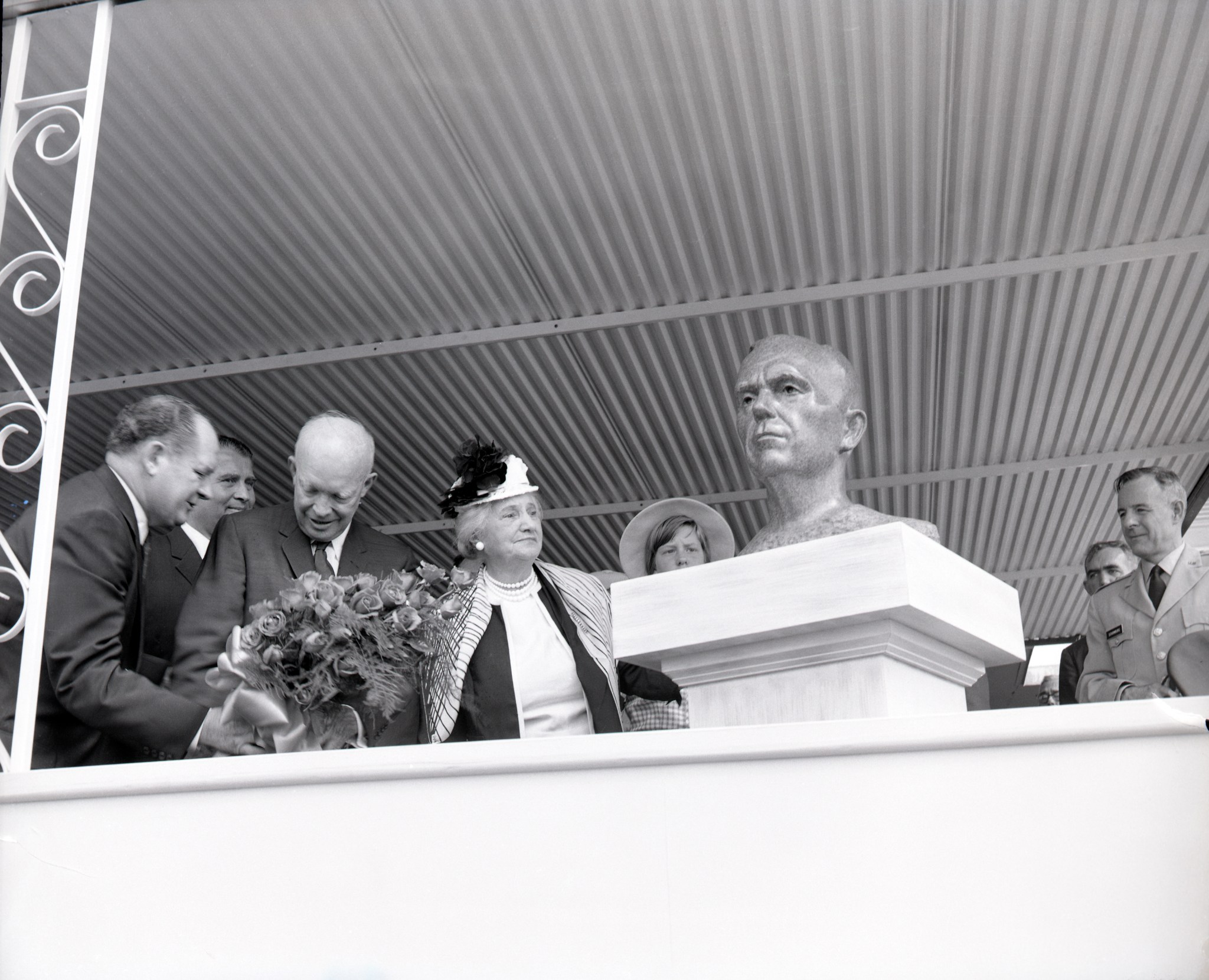
This week in 1960, President Dwight D. Eisenhower visited Huntsville to formally dedicate NASA’s Marshall Space Flight Center. The center was named in honor of Gen. George C. Marshall, Eisenhower’s wartime colleague and namesake of the famous Marshall Plan for European recovery following World War II. Here, Eisenhower and Marshall’s widow, Katherine Marshall, unveil a granite bust of the general during the center’s dedication ceremony. The NASA History Program is responsible for generating, disseminating, and preserving NASA’s remarkable history and providing a comprehensive understanding of the institutional, cultural, social, political, economic, technological, and scientific aspects of NASA’s activities in aeronautics and space. For more pictures like this one and to connect to NASA’s history, visit the Marshall History Program’s webpage. (NASA)

























